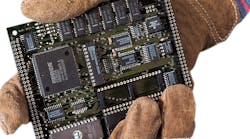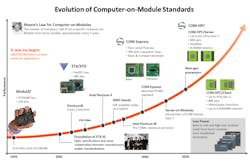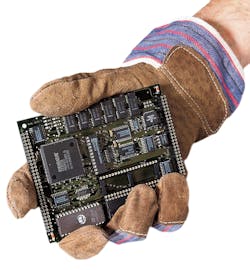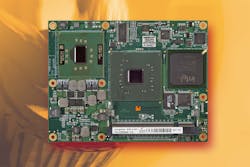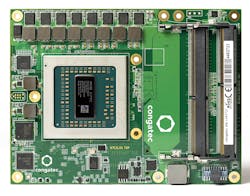Computer-on-modules (COMs) have established themselves as the most important design principle for embedded computer systems over the many years that the COM concept has existed (Fig. 1). Studies such as those by IHS Markit predict that COMs will account for around 38% of the total sales of embedded computing boards, modules, and systems by 2020.1
1. ETX and the COM Express standard, the latter evolving from ETX, are two computer-on-module specifications that have been standardized by independent bodies in line with technological progress. With COM-HPC, a third standard is now being launched to meet the high-performance requirements of broadband and 5G connected devices, machines, and systems.
The first modules appeared in the early 1990s, when Hans Mühlbauer—then owner of German company JUMPtec and still involved in the activities of congatec AG today—introduced the first ModulAT (Fig. 2) modules based on the then common AT/ISA96 bus. They were equipped with a 9.54-MHz Intel CPU 80C88 and offered 640 kB of DRAM. The aim was to make office PC technology suitable for industrial use. That was something the embedded computer world hadn’t seen before.
2. The first ModulAT modules from JUMPtec were based on the then-common AT/ISA96 bus and equipped with a 9.54-MHz Intel CPU 80C88 and 640 kB of DRAM.
At the time, industrial PCs predominantly came as 19-in. rack systems. An industrial-grade computer on a board measuring only 100 × 160 mm was unheard of. The module executed 120 pins on the same side as the CPU and the components; processors obviously didn’t require complex thermal management back then.
The goal of these first modules was to avoid putting all functions on one card in order to cushion the fast CPU innovation cycles. Back then, Intel and AMD launched new CPUs every six months. Because it wasn’t certain how long old CPUs would be available, it was necessary to ensure the required long-term availability via modules. Of course, this scalability also helped to create multiple performance variants.
Another important argument was to reduce the complexity of I/O board design. As a rule, I/Os require significantly fewer layers, which lowers the cost of PCB design. How to reduce power consumption and the amount of heat waste with each new module already played a role back in those days as well. And ultimately, customers always want the latest CPU—that was true then just as much as it is today. This advantage can also be easily ensured with modules.
Modules Also Solved Cable Clutter
However, compared to the related AT/ISA96 bus, the ModulAT modules came rather late to the market since embedded computing for harsh industrial applications was still in its infancy. For example, x86 and Windows had yet to be established in the industry, and the fight against the blue screen was still ongoing at the time. In this respect, the modules were more like early “pirate” products of a new startup industry than the distinct product lifecycle of a whole generation of an established module standard. Nonetheless, JUMPtec was the company that opened the specification and pioneered the global module business. And it proved to be a success, as developments emerge to this day.
The PC/104 SBC form factor, which offered too little space for connectors if they had to be mounted on the same side as the CPU and chipset, provided another sound argument for modules in the mid-1990s. With customers starting to demand more connectivity, connectors were custom-mounted on the other side of the PCB to connect even more peripherals. The PC/104 design principle also meant that cables had to be used to route the I/Os to the housing. This led to bigger and bigger cable tangles, which in turn increased system error susceptibility.
At that time, good system design was characterized by clean and tidy cabling. Containing cable clutter by connecting the external I/Os to the housing without cables via an application-specific carrier board was therefore an important argument in favor of the module concept. The launch of the first ETX modules developed by JUMPtec marked the breakthrough for the computer-on-module market.
Hard Contest for Best Module Concept
However, to start with, the ETX form factor for these ISA/PCI-based modules with 400-pin connectors to the carrier board didn’t have an easy ride—despite the fact that JUMPtec had opened the specification. Many companies and competing module concepts, which are remembered only by die-hard insiders today, courted OEMs with comparable solutions. There was fierce competition between embedded computing vendors, who weren’t as big back then as they are today.
JUMPtec and Advantech joined forces in November 2001 to found the ETX Industrial Group (ETX-IG), which introduced the first open, manufacturer-independent module standard and maintained a version that’s still valid today (Fig. 3). “Advantech, I-Base, IBR, and PCISystems, for example, developed alternative ETX boards and rapidly brought them to market maturity. To ensure the uniform worldwide development of the ETX standard, it was therefore necessary to establish an open ETX consortium,” explained Mühlbauer at the time.
3. The foundation of ETX-IG at the SPS/IPC/Drives in Nuremberg by Advantech and JUMPtec.
Within a few months, the most important other ETX proponents also joined the consortium, as they all felt the great benefits of an open standard. Later on, the module forest of alternative form factors significantly thinned out due to the growing importance of ETX-IG as well as various mergers and acquisitions. Ultimately, it was almost completely cleared, so that the next technology cycle was able to establish itself as the new standard of the embedded computer-on-module industry with significantly less saber-rattling.
COM Express Becomes Official PICMG Standard in 2005
The widespread introduction of the new PCI Express bus and the elimination of ISA support in the new processors and chipsets required a new concept in 2004: COM Express, which was comparatively easier, although not entirely painless to establish. Some trench warfare and delay tactics had to be fought within the PICMG, which was to host this standard. Ultimately, the embedded community managed to agree on the COM Express standard within the PICMG, but not before July 2005 (Fig. 4).
4. The first COM Express modules were launched into series production in 2005 with the Intel Pentium M processor, which was a real milestone processor for the embedded-computing market.
So, from the first presentation of the concept in collaboration with Intel in the autumn of 2003, it took a good 18 months until standardization. From Rev 2.0 in 2010 up to the current Rev 3.0 from 2017, the specification was developed under the continuous leadership of draft editor Christian Eder, who initially worked under Mühlbauer at JUMPtec and later at Kontron, and now works at congatec.
Today, a full 14 years after the PICMG launched COM Express, the computer-on-module market is, as previously mentioned, the largest and most dominant embedded computing submarket. All major embedded computer manufacturers offer a wide variety of COM Express modules. Having said that, ETX/XTX modules are still available today, which means that the first COM cycle hasn’t yet ended. And it took several years, until 2012 to be precise, for COM Express to outperform the ETX/XTX form factor in terms of quantities. “Never change a winning team” is a motto that’s popular in the embedded computing market.
COM Express Modules are Unrivaled
Currently, COM Express modules are also the undisputed standard for new embedded carrier-board designs in the mid to high-end performance class. And there’s not a competitor in sight. The standard, incidentally, went through various rather silent revisions up to the current version 3.0, which was published in May 2017; this certainly also counts as a merit of standards.
In its relatively new Type 7 specification, COM Express is predestined for embedded edge servers (Fig. 5), and for extreme applications, it’s even used as a basis for VITA specifications. Alternative module standards such as Qseven and SMARC 2.0, which both also support Arm-based application processors, have established themselves only for the low-power/small form factor segment.
5. The most powerful COM Express Type 7 server-on-module to date is equipped with the AMD EPYC processor.
Lessons from the past were learned for the new COM-HPC module standard: Right from the outset, this standard for high-performance embedded computing was developed within the PICMG to avoid module battles as far as possible. There’s no better fitting ecosystem for this third generation of module standards than this manufacturer-independent consortium.
The Third Generation of High-Performance COMs Looms
Since October 2018, the PICMG working group has been working under the chairmanship of congatec’s Christian Eder on the new COM-HPC module specification. It’s urgently needed because the COM Express inter-board connector can no longer support the upcoming high-bandwidth, high-frequency communication buses required for all types of new IoT/5G-connected devices. This means the global computer-on-module specifications have been conceived and promoted for decades in the same German COM forges.
Currently, the driving force is congatec AG, the company that started in 2005 as a pure module company to avoid competing against its own customers with system solutions. It’s also the idea generator behind Qseven and SMARC 2.0.
Broadband Internet Needs Broadband Computers
As with the switch from ETX to COM Express, the introduction of new bus technologies is leading to a new standard. The aim of the COM-HPC specification is to create a new computer-on-module standard for broadband computing over broadband internet that’s suitable for the new high-frequency signals from PCI Express Gen 3 to 5. However, COM-HPC should not be seen as a replacement for COM Express, just as COM Express wasn’t the replacement for ETX.
As mentioned earlier, ETX/XTX modules are still available today, allowing customers to continue to work on the basis of the same design principles even after 20 years. In this respect, the upcoming new COM-HPC module standard is also proof that the basic concepts that were valid then are still valid today. In addition, the tasks associated with the design-in of new processors have become much more complex, which is why it makes even more sense today to decouple the I/Os from the processor module via an application-specific carrier board (Fig. 6).
6. COM-HPC modules from congatec will be available in two performance classes: a client (top) and a server (bottom) class, as with COM Express Type 6/7 today. From the outset, two footprints are specified for each class, which means that the larger high-end COM-HPC modules will probably be able to host up to 8 DIMM sockets. The graphic also clearly shows the identical placement of the inter-board connectors for the different sizes.
But why not simply develop COM Express further? The new COM-HPC standard doesn’t just require a new connector; there are more legacy COM Express features that are no longer needed and must be thrown overboard. That’s because the new standard targets applications with requirements well above the current top COM Express performance class. However, the overall aim is to offer OEMs the benefits derived from the large ecosystem and reputation of the PICMG and its standards, which is why there’s emphasis on making migration as easy as possible for customers. Ample experience from migrations from ETX to COM Express should be available.
For these reasons, there will be two more or less entirely new next-gen performance classes above the COM Express specifications Type 7 and Type 6. One is aimed at edge server technology, which requires more communication interfaces instead of integrated, powerful graphics, and will bring an extremely large number of cores for workload consolidation. The other expands the existing high-end embedded computing with new performance options that COM Express can no longer cover, which also comprises graphics. The list includes USB 3.2 with 20 Gb/s, USB 4.0 with 40 Gb/s, PCIe Gen4/5 with x2/x4 port configuration and re-timer, 100/200 Gb/s Ethernet, NVMe, and much more.
Twice as Many Pins and Up to 8 DIMM Sockets
An essential part of the new specification is the connector. COM Express, for instance, is limited to PCIe Gen 3.0 with 5.0-GHz clock rate and 8 Gb/s. The new connector supports transfer rates of more than 32 Gb/s, which is adequate up to PCIe Gen 5.0. In addition, there are now up to 64 PCIe lanes to the carrier board—enough to connect many powerful GPGPUs for machine learning, for example.
COM Express, by comparison, supports a maximum of 32 lanes. The COM Express performance, currently limited to 10-Gb Ethernet per signal pair, will also increase to at least 25-Gb Ethernet per signal pair, enabling support for up to 100-Gb Ethernet. The new processor generations for edge computing also require more interconnects than before, as well as more space for DIMM sockets than previously possible. Current plans allow for up to 8 DIMM sockets and 800 pins to the carrier board; COM Express has only 440 pins.
Developing a new standard is no easy matter, even if some might think so. The complexities arising just from increasing the signal frequency are already enormous. For example, congatec and Samtec have been working together for a full two years on COM-HPC connector requirements and tests to be able to support modules up to 300 W. The PICMG working group, however, wasn’t set up until October 2018. This shows how much groundwork was already done, speeding up the decision-making process in the working group itself.
When Will COM-HPC Modules be Available?
The companies involved in the standardization process are probably all secretly holding their breath that the processes will not be blocked again in the PICMG, as happened with COM Express. Success depends largely on no company pushing ahead without the others. That’s why the entire community is discreetly holding back on public announcements.
However, the development departments are already working at full speed on first design studies based on the latest processor technology, which semiconductor manufacturers such as Intel are sharing via early access programs. The first production-ready COM-HPC modules from congatec will probably become available in early 2020, when the next major embedded-computing generations are expected to launch. This leaves about as much time as there was for COM Express. So, it should be achievable.
About the PICMG
The PCI Industrial Computer Manufacturers Group, or PICMG for short, is a consortium of over 140 companies that jointly develop patent-free specifications for high-performance telecommunications and industrial applications. The members of the consortium are for the most part technology pioneers with many years of development experience in their industries.
Currently, the group is developing the COM-HPC specification as an open architecture for the next generation of computer-on-modules. Companies involved in the development of the COM-HPC specification include Adlink, congatec, and Kontron as sponsors of the working group, as well as Advantech, Amphenol, Bielefeld University, Elma Electronic, Emerson Machine Automation Solutions, ept, Fastwell Group, Heitec, Intel Corp., MEN Mikro Elektronik, MSC Technologies, N.A.T., Samtec, SECO, TE Connectivity, Trenz Electronic, and VersaLogic. The chairman is Christian Eder of congatec.
Dan Demers is Director of Sales & Marketing – Americas at congatec Inc.
Reference:
1. http://embeddedtechtrends.com/2017/PDF_Presentations/M06%20-%20IHS%20Markit.pdf
